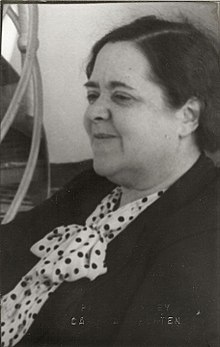Elsa Maxwell
From Wikipedia, the free encyclopedia
| Elsa Maxwell | |
|---|---|

Maxwell photographed by Carl van Vechten
|
|
| Born | May 24, 1883 Keokuk, Iowa, U.S. |
| Died | November 1, 1963 (aged 82) New York City, New York, U.S. |
| Nationality | American |
| Occupation | Gossip columnist, author, songwriter, hostess |
Maxwell is credited with the introduction of the scavenger hunt and treasure hunt for use as party games in the modern era.[1] She also appeared as herself in the films Stage Door Canteen (1943) and Rhapsody in Blue (1945), as well as co-starring in the film Hotel for Women (1939), for which she wrote the screenplay and a song.
Biography
In spite of the persistent rumor that Elsa Maxwell was born at a theater in Keokuk, Iowa, during a performance of the opera Mignon, she actually admitted late in life that the outlandish story was a fabrication that she went along with, since she was actually born at her maternal grandmother's home in the same town.[2] Elsa was subsequently raised in San Francisco, where her father sold insurance and did freelance writing for the New York Dramatic Mirror.[3] She developed a gift for staging games and diversions at parties for the rich, and began making a living devising treasure-hunt parties, come-as-your-opposite parties and other sorts, including a scavenger hunt in Paris in 1927 that inadvertently created disturbances all over the city.[3]In Venice in the early 1920s, Maxwell attracted stars like Cole Porter, Tallulah Bankhead, Noel Coward and Fanny Brice to Venice's Lido shoreline to enjoy its daytime amenities and nightly parties.[4] Later, the principality of Monaco employed Maxwell's services to put it on the map as a tourist destination as she had done for the Lido. Maxwell and Porter were lifelong friends, and he mentioned her in several of his songs, including "I'm Dining with Elsa (and her ninety-nine most intimate friends)" and "I'm Throwing a Ball Tonight" from "Panama Hattie" (sung by Ethel Merman.)[5]
Returning to the US, Maxwell worked on movie shorts during the Depression, unsuccessfully. "Her imprimatur of social acceptability carried so much weight that the Waldorf Astoria gave her a suite rent-free when it opened in New York in 1931 at the height of the depression, hoping to attract rich clients because of her."[4] Following World War II she gained an audience of millions as a newspaper gossip columnist.[3]
Maxwell took credit for introducing Rita Hayworth to Prince Aly Khan in the summer of 1948.[6] In 1953, Maxwell published a single issue of her magazine, Elsa Maxwell's Café Society, which had a portrait of Zsa Zsa Gabor on the cover. Anne Edwards' biography of Maria Callas (Callas, 2001) and Peter Evans biography of Aristotle Onassis both claim that Maxwell introduced Callas to Onassis.[7][8] Edwards also claims that Maxwell was a lesbian who tried to seduce Callas, 40 years Maxwell's junior.[9] Callas biographer Stelios Galatopoulos produced love letters from Maxwell written to Callas, who was less than receptive.[10]
Maxwell told interviewer Mike Wallace in 1957:
I did not feel fit, to be only married. I belong to the world. I knew it instinctively when I was quite young. I belong to the world. Certainly I am the most shall we say immodestly, [among] the best-known people in the entire world today. Why, because I did not marry and I felt that I was not for marriage. It wasn't my ... thing to do.[11]She died of heart failure in a Manhattan hospital.[3] Her longtime friend Dorothy "Dickie" Fellowes-Gordon was Maxwell's sole heir.[12]
Bibliography
- RSVP: Elsa Maxwell's Own Story (1954) by Elsa Maxwell, Little, Brown and Company
- How To Do It, or The Lively Art of Entertaining (1957) by Elsa Maxwell, Little, Brown and Company
- Inventing Elsa Maxwell (2012) by Sam Staggs, St. Martin's Press ISBN 978-0-312-69944-4
- I Married the World, by Elsa Maxwell.
No comments:
Post a Comment
Please leave a comment-- or suggestions, particularly of topics and places you'd like to see covered